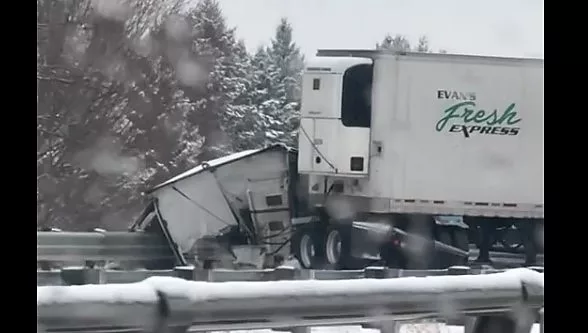
UPDATE: All lanes are now open on I-94 westbound after Exit 27.
A burst of afternoon snow caused near whiteout conditions in St. Joseph, Benton Harbor and across southwest Michigan. Several inches of snow fell in a short period of time, and many traffic incidents have been reported by the Michigan Department of Transportation, including a closure of Westbound I-94 after M-63, west of exit 27.
Michigan City resident Brandi Lacefield posted a video to Facebook showing the wreckage, which appears to involve multiple semi trucks over Lincoln Avenue in Berrien County. Multiple emergency vehicles were on the scene. Watch the video below:
Those making their evening commute should be advised of dangerous road conditions in the area, and take proper precautions. In light of the conditions, the Berrien County Road Department has shared a guide from the state of Michigan with tips on how to avoid crashes this winter:
- It can take up to ten times longer to stop your vehicle on snowy and/or icy roads. Slow down and allow more room between your vehicle and the one ahead of you. This gives you more time to react and brake, reducing your crash risk.
- Put your turn signal on sooner than you would in warm weather months. Remember, it takes longer for the cars behind you to react and stop, too.
- Avoid distractions now more than ever. Taking your eyes off the road for even a few seconds robs you of precious reaction time. Put your phone away and don’t try to multitask (eating, putting on makeup, etc.).
- Watch for black ice. Black ice, a very thin and nearly invisible layer of ice that makes the road look wet, is another reason to slow down this winter. Stay alert for black ice on bridges, ramps and overpasses, after sudden drops in temperature, and in shaded areas.
- Avoid a ticket. Michigan laws require drivers to move at a speed that is “reasonable and proper” for the road conditions. Even if you are driving at or below the speed limit, you could get a speeding ticket if the road conditions make that speed unreasonable for safe driving.
“BUT I HAVE FOUR-WHEEL DRIVE!”
- Front-wheel-drive (FWD), all-wheel drive (AWD) and four-wheel-drive (4WD) vehicles are less likely to slip during acceleration than a rear-wheel-drive (RWD) vehicle. However, FWD, AWD and 4WD vehicles are just as difficult to stop and turn on wintry roads as RWD vehicles. So slow down!
- Because FWD, AWD and 4WD vehicles are less likely to slip during acceleration, their drivers may not recognize dangerous road conditions until they try to stop or turn—and by then they may be driving too fast to stop safely. (So slow down!)
CHILL SKILLS: TECHNIQUES FOR SAFER WINTER DRIVING
- Don’t make any sudden moves. Accelerate and brake smoothly and gradually — no stomping on the brake or gas pedal.
- Steer into a skid. If your vehicle begins to skid, first take your foot off the accelerator. Then steer in the same direction the rear of your car is sliding. In other words, if the rear end of your car is swinging to the right, turn your steering wheel to the right. Don’t steer violently, or you’ll just skid in the opposite direction.
- Work on your ABS. With an antilock braking system (ABS), when your car skids and you step on the brakes, you may feel a pulsing sensation. This is normal—do not let up on the brakes! ABS will prevent your wheels from locking during a skid, giving you greater steering control. It will not help you stop more quickly, however. So, keep driving slow on ice and snow.
- Don’t cruise. Using cruise control on ice and snow can be dangerous. If your car skids, the cruise control will accelerate to maintain a constant speed —spinning your wheels even faster and increasing the chance you will lose control of your vehicle.
- Keep the lights low. If you’re driving in snow, rain or fog, reduce reflective glare by putting your headlights on low beam.








